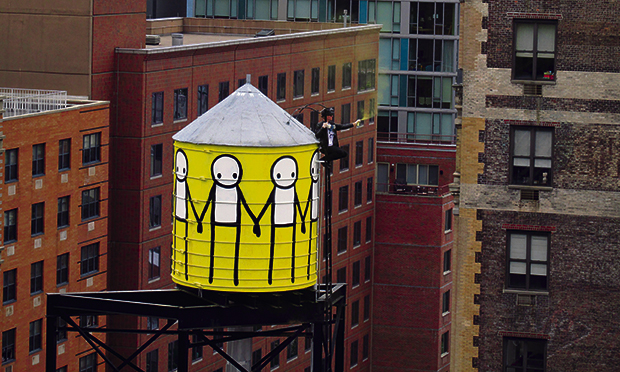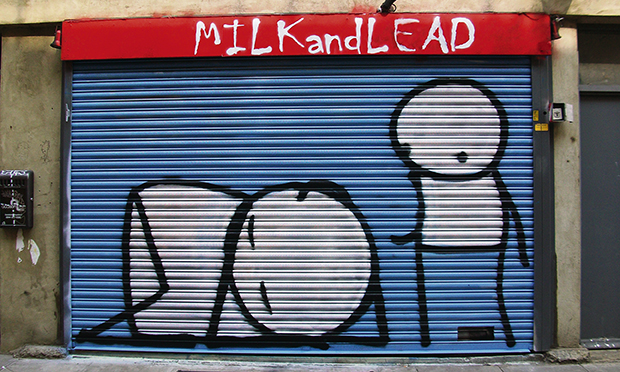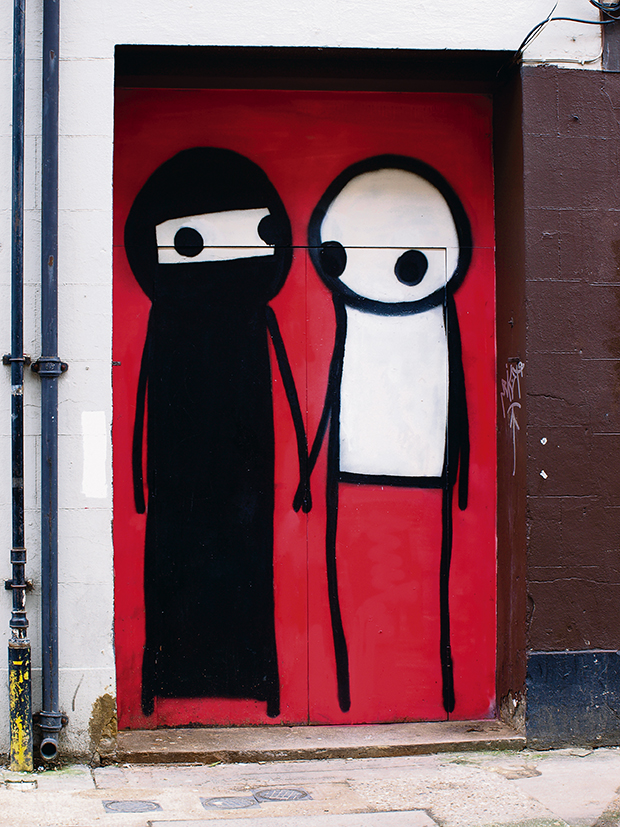'That's me in the painting' – how Stik became a street art icon
I make it to Foyles at 6.30pm on the dot to find a queue spilling from an excited throng in the auditorium. The line runs down the stairs and out into the cafe, where a second – non-priority – queue begins. “It’s the busiest book signing I can remember,” a flustered employee tells me.
The heaving crowds have turned out in force to pick up a copy of street artist Stik’s eponymously-titled new book and get it signed by the mysterious man himself – who, perched on a raised platform, is donning a paint-spattered shirt, dark shades and a black leather cap.
His heavy, rose-coloured publication documents a curiously affecting, politically-motivated body of work that relies primarily on basic stick figures. It’s a portfolio, so to speak, that first started to appear on Hackney’s walls more than a decade ago and has since spread across the globe.
A few days later, we chat on the phone and he’s as genial as he was with fans earlier in the week. “It was incredible”, he says of the event. “I was only supposed to be doing an hour, but in the end I stayed there for about three.”
Softly spoken and oozing enthusiasm, Stik is keen to talk about his connection with this publication’s sister title, the Hackney Citizen. Roughly half a decade ago, whilst living in St Mungo’s Hostel on Mare Street, he began a fruitful collaboration with the paper, which, he explains, gave him a structure that would eventually lead to his first book.
“I’d speak to the editors and we’d pick a local news story. I would find a specific place relevant to that story, do a mural and then I’d write a brief column explaining why that painting was there and what news issue it was relating to,” he says.
“Doing that monthly piece really made me think about street art on a much deeper level and what sort of impact I could have on the community – how I could represent my community through art. So that was the catalyst for the book.”
The original publications make for an interesting stand-alone project. The first he sends across to me includes an image of Pole Dancer, a 2010 piece scrawled outside a strip club in Great Eastern Street. The work portrays one of his signature black-and-white stick people swinging, eyes closed,
around a pole.
“That was in reference to Hackney Council’s move to clamp down on what they deemed indecent sex clubs,” he says. “They cut out a lot of the healthy, consenting adult subculture in Hackney under the guise of trying to curb sex trafficking… So, yeah, I did that piece to sort of celebrate the kink culture and just draw reference to what
was happening.”
Other examples of Stik’s work that were produced during that time include Lovers, Waiting Room and Children of Fire; these were done in response to the council’s eviction of a Dalston Lane ‘queer squat’, cuts to the NHS, and the “civil unrest… triggered by the police killing of Mark Duggan”, respectively. He goes on to explain that, as well as conveying a wider social message, each mural contains a narrative personal to him.
Of Lovers, which shows two androgynous figures embracing against a red background, he says: “The squat was a safe house for people from oppressive regimes, for queer and transgender people who were not safe in their home towns or home countries… There was no real service like it within the mainstream infrastructure – this was something that was lacking.
“But it was also a place which I had a personal connection with. I belonged to that community, you know, that’s me in the painting. A lot of it is my story – it’s my experience of being marginalised, of being oppressed and how that relates to society at large.”
It’s interesting that Stik describes his work as a means of telling his own story. Outside of his art, biographical details are sketchy. His email moniker is simply Stik Person and he stresses a set of “strict rules” when it comes to answering questions about his past – it’s not even known where he originates from.
He does, however, talk relatively freely about his time in Hackney, which, going by artistic evidence, began sometime around 2003. He explains that when he first arrived he spent time squatting in London Fields Lido, during the period leading up to its renovation and reopening in the mid-2000s.
“I used to live in the changing rooms there,” he says. “I slept in an art shipping case that I’d salvaged from Momart, the art shipping company. It was a plywood packing case that according to its label once contained a Kandinsky and was destined for, I think, Claudia Schiffer, somewhere in Hollywood.”
At this point, I’m not sure if he’s pulling my leg, but he goes on to describe what sounds like a dark, difficult and deeply informative period of his life.
“I was homeless for many years and I was very cold and hungry for a long time,” he says, “but I would always find abandoned buildings. I didn’t have any reason to sleep in doorways in Mare Street because I always managed to somehow get through the door.”
He refers back to the Pole Dancer piece: “It’s very personal to me. When you’re homeless you find all sorts of ways of making a living and I’ve had to make ends meet through all sorts of things. That’s why I identify with the struggle of sex workers in Hackney and the stigmatisation that they’ve had put on them.”
The more he talks, the more enigmatic and fascinating he becomes; the more complicated his work is. He describes with zeal his many experiences painting abroad – the highlight, for me, being a set of wind turbines he worked on in Norway – and what the future holds now the world is interested.
“I feel very warmly embraced by the communities that I have worked with,” he says. “I feel very grateful as an artist for that experience. It’s an exciting journey – it’s a huge responsibility, but I do feel that it’s my responsibility as an artist to respond to the current political state of affairs.”
Stik’s book, which forms one mammoth project, is a triumph. His pared-down, sublimely minimal approach delivers touching snippets of human experience and explores private city space in a dramatically public manner. He’s both engaged and engaging; it’s easy to understand his fast-rising popularity in the art scene.
As we tie up our conversation, Stik makes an obscure reference to Somerset, and when I ask more he shrugs it off and mutters something about friends and some work he’s got going on there.
I can’t help but feel it’s a hint at a previous life; another scrap of the obscure biography he’s been scribbling on walls everywhere. I can’t be sure, but it’s fun to speculate.
Stik is published by Century. RRP: £20. ISBN: 9781780893334
Stik’s Print Launch is on 24 September from 5-8pm at the Education Centre, Homerton University Hospital, Homerton Row, E9 6SR




